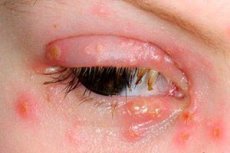Medical expert of the article
New publications
Herpes on the eyelid
Last reviewed: 04.07.2025

All iLive content is medically reviewed or fact checked to ensure as much factual accuracy as possible.
We have strict sourcing guidelines and only link to reputable media sites, academic research institutions and, whenever possible, medically peer reviewed studies. Note that the numbers in parentheses ([1], [2], etc.) are clickable links to these studies.
If you feel that any of our content is inaccurate, out-of-date, or otherwise questionable, please select it and press Ctrl + Enter.

Herpes on the eyelids can most often be preceded by respiratory diseases, hypothermia or overheating of the body, contact with a patient with chickenpox. Keratitis, iridocyclitis, optic neuritis, paralysis of the external muscles can develop, even several months or years after the disease.
Symptoms of herpes on the eyelid
Simple herpes on the skin of the eyelids appears as blisters, erosions, then a crust forms. Healing of herpes on the eyelids occurs without scars, the general condition is almost not affected. The patient complains of burning, tingling at the site of the eyelid lesion. Histological examination reveals changes in the cells of the spinous layer, in the epidermis - serous exudate. In the dermis - edema, vasodilation.
Viral infection of the node or branches of the trigeminal nerve, depending on which branches of the trigeminal nerve are affected, typically affects the upper, but sometimes the lower or both eyelids, the corresponding half of the forehead, nose, conjunctiva of the eyeball, and when the nasopharyngeal nerve is involved in the process, the cornea and iris. The rash is sharply delimited along the midline of the forehead and nose. The incidence of herpes zoster on the eyelid increases sharply with age, and is more common in people over 50 years of age.
Symptoms of herpes zoster on the eyelid: lacrimation and photophobia, hyperemia and swelling of the skin of the eyelids; against this background - a rash of blisters with transparent contents, which can merge and subsequently take on a purulent, bloody or gangrenous character, then crusts form.
Shingles on the eyelid has the following forms:
- abortive form of herpes zoster on the eyelids - red spots appear on the eyelids and then disappear;
- hemorrhagic form of herpes zoster on the eyelids - the blisters merge, hemorrhagic discharge appears;
- gangrenous form of herpes zoster on the eyelids - ulcerative surface after removal of pustules, then a scab forms, scarring. After this form of the disease, eversion, inversion, and trichnia of the eyelids may form.
The general condition suffers - general malaise, increased body temperature, severe neurological pain with simultaneous anesthesia ("painful anesthesia"), hyperesthesia or paresthesia in the area innervated by the affected first. If the pathological process involves n.nasociliaris, rashes appear at the inner corner of the eye slit. Enlargement and soreness of regional lymph nodes are characteristic.
 [ 8 ]
[ 8 ]
Where does it hurt?
What do need to examine?
How to examine?
What tests are needed?
Treatment of herpes on the eyelid
Simple herpes on the eyelid is treated with immunostimulants, ointments (oxolinic, theobrofen, florenal) are prescribed locally. It is necessary to eliminate predisposing factors - hypothermia, contacts.
Treatment of herpes zoster on the eyelids involves hospitalization in severe cases in a dermatological hospital, where consultation with an ophthalmologist and neurologist should be provided.
- Oral analgesics.
- Lubricate the rash with 5% acicdovir ointment (Zovirax) or 1% alcohol solution of brilliant green.
- Antiviral therapy is carried out (virolex, iododeoxyuridine, oxoline, florenthal, helepin, interferon, vitamins A, B, C, E; corticosteroids in microdoses).
More information of the treatment

